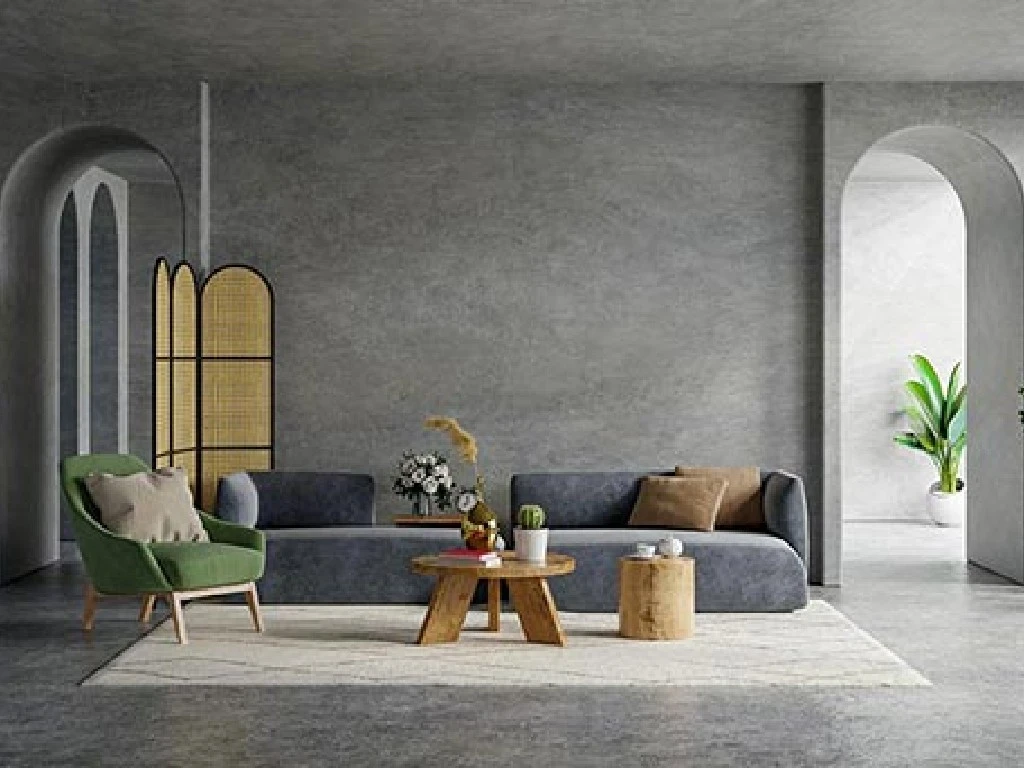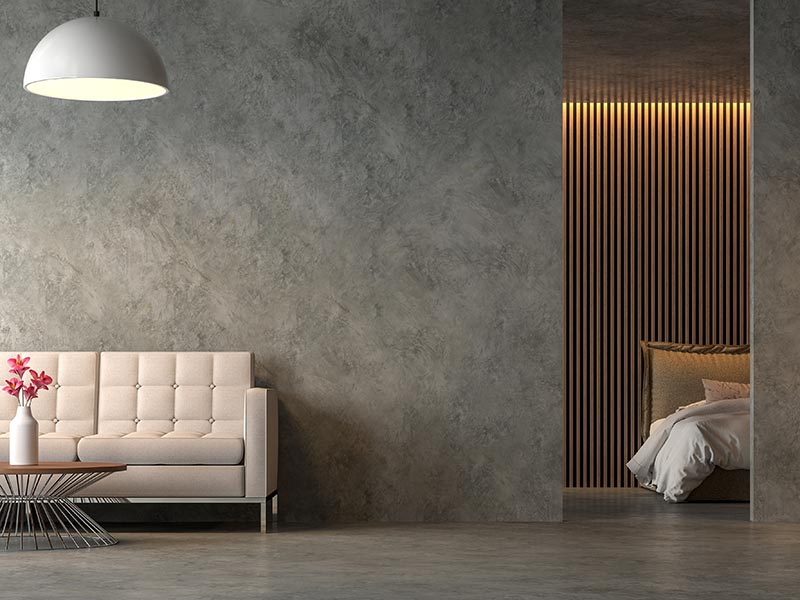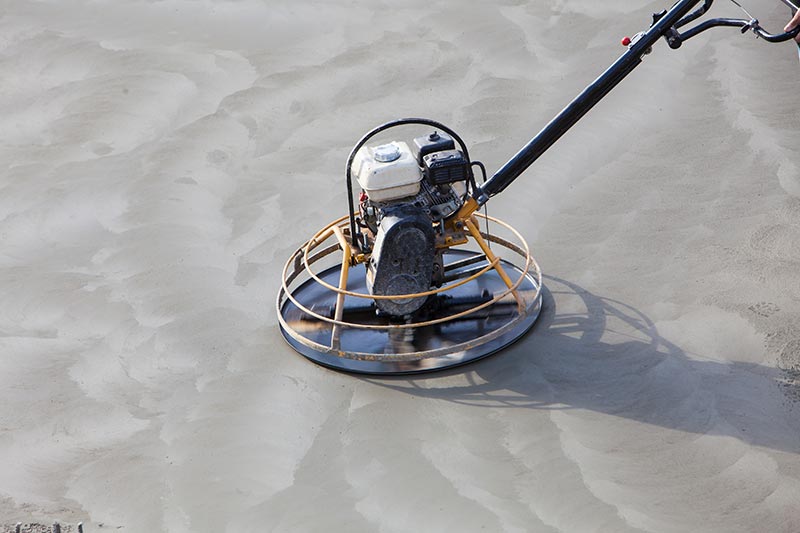Should you use polished concrete in your next interior design?

There is something about polished concrete floors that draws you in when you first enter a home. Surprisingly, I can recall when I first walked into a house with polished concrete.
I was really taken aback by it when I first entered the home. It was an industrial style home located in Sydney. It had grey polished concrete floors throughout the entire house, including bedrooms and bathrooms, and polished concrete countertops in the bathrooms and kitchen.
If you had asked me beforehand about polished concrete floors throughout an ENTIRE home, my response would have been, NO, not the entire home, possibly just the kitchen, garage, and maybe the bathrooms – but certainly not the bedrooms.
BUT I loved it! The house felt sturdy, modern and even cosy! It was impressive. If I imagine the same house with a cream carpet and vinyl flooring, it definitely does not have the same feel. Come to think of it, I don’t think I’d really remember this house at all.
There are so many types of flooring, and with most of them, can you really tell the difference?
I know I can’t most of the time! One thing is for sure – you definitely notice fresh shiny wet looking concrete floors.
BUT….
- What does the maintenance look like?
- How often does it need to be repolished?
- Polished concrete seems cold and stark. Can you get underfloor heating with polished concrete?
- How often does it need to be repolished?
This article is to help you narrow down your flooring choices and decide if polished concrete is the right choice for your building project.
Whether you are building a corporate complex, cosy country home or a suburban city masterpiece here are a few things to keep in mind whilst reading,
- What are you trying to achieve with your home or commercial build?
- What level of maintenance can you commit to?
- Is it a high-traffic area?
At Gunlake Group, we have been assisting builders and property developers with creating polished concrete floors for their clients for over 30 years. The trick is to continually innovate and work with property developers to deliver a high-quality product that satisfies budgetary, and timeline demands.
What is polished concrete?

We are talking about true polished concrete here.
Polished concrete is a no-wax flooring material, unlike hardwood, terracotta, natural stone or wood laminate. The smooth lustrous look of polished concrete is accomplished by using high-end polishing machinery through a multi-step process of grinding and buffing the concrete surface.
New and existing concrete can be polished depending on the condition. On the whole, though, most existing concrete can be freshened up with a polish.
You can also choose the look you prefer, whether it be a matte or high gloss. The difference is that the matte look is achieved by ending the polishing process after a few polishes and the high gloss look is achieved by continuing on longer using a higher grit.
How do you clean polished concrete floors?
Polished concrete is an extremely durable and sustainable flooring option. They can last well over 20 years with minimal but thorough maintenance. And are much easier to maintain than other types of flooring.
When it comes to regular cleaning, it is best not to overthink it. Simply vacuum to remove dirt and dust, then mop with warm water. Microfibre mops work well but are not essential. You can use mild floor cleaners often referred to as PH neutral cleaners, including liquid dish detergent and castile soap. BUT I wouldn’t recommend using even mild soaps every time you clean.
Cleaners specifically for polished concrete floors are available but, again not essential. These cleaners can be good because they leave behind a dirt-resistant film. Best not to use highly acidic cleaners such as ammonia, pine-based cleaners or vinegar. Over time highly acidic substances will dull the shine and slowly erode the concrete.
The frequency of the cleaning will depend on the amount of traffic the floors receive. Frequently used areas like entry points will need more frequent cleaning.
What does the maintenance look like?

This is where the REAL decision-makers or breakers come in!
A repolish is needed every 2-3 years. This may seem frequent, but when you think of how often hardwood floors need to be repolished, every 6-12 months. It’s not that much. If you follow the simple cleaning instructions, you will be able to get away with repolishing concrete floors every 4-5 years.
The good thing about mechanically polished concrete floors is there is little to no downtime with maintenance. You can walk on them straight after. There’s no top coating, where you need to wait for the floor to dry.
Authentic polished concrete floors shouldn’t peel, scratch or need a sealant application over the usage lifetime. Their high durability means they can handle heavy foot traffic and are extremely hard to chip or scratch.
Yes, on the odd occasion, cracking can occur. Structurally, cracking is rarely a major concern. In fact, concrete has a series of micro-cracks not visible to the naked eye. Major cracks can be easily repaired during the maintenance process.
Think back to the last time you were in a factory, shopping centre or hospital. All high foot traffic areas with lots going on. Most of the time, these places have concrete floors. And for a good reason! They don’t have the ability to shut down or be disrupted by long periods of maintenance. Concrete floors are also an extremely hygienic flooring type, as the surface does not trap dust, or other allergens, which makes concrete flooring even more attractive when it comes to choosing flooring options.
How to make polished concrete cosy and inviting

Now for the more creative, less technical side of concrete floors.
You can install underfloor heating with polished concrete floors – A BIG yes, please! Underfloor heating and concrete floors go together like a fresh gin and tonic.
Polished concrete is ideal for heating. They are made for each other. Concrete has a quick heat-up time and retains the heat well all thanks to its high thermal mass.
Polished concrete floors will also heat up nicely by the sun. If you have spaces that let in the natural sunlight across the floors, you will notice that these areas will stay nice and cosy even as the sun goes. This reduces the amount of time artificial heating is needed— something to keep in mind when planning your builds.
You do have a range of finish options with concrete. It’s not just your light greys. Choose from matte, gloss or high gloss finish. Then you have your exposure types including nil exposure, think of an industrial stylish office in downtown San Francisco, to full exposure, which is an ultra ‘salt and pepper’ look.
The exposure types are accomplished by grinding the surface with machinery to reveal the aggregate. For example, minimal exposure is achieved by lightly grinding the surface to reveal small amounts of stone.
Full exposure with high gloss polished concrete floors LOOK incredible and will certainly make your space memorable.
Are there any cons to polished concrete floors?

Ok, this all sounds great, but surely there are some downsides to polished concrete floors.
Yes, there are some downsides, but to be honest, they are not too major, and we have covered some already.
A common concern is that they will be cold. Well, underfloor heating easily overcomes this issue. Underfloor heating is also more economical than forced-air- systems, substantially lowering your costs of living.
Another common concern is that they can be hard and loud. For high traffic areas, you can add rugs or mats, mitigating both the hard and loud concerns as well as reducing the wear and tear in the high traffic areas. Once you start styling your space with drapes and furniture, this further diminishes the noise concerns.
Will you choose polished concrete floors for your next building project?
Let polished concrete be the shining lighthouse guiding you through the time-consuming sea of sameness flooring choices. Polished concrete floors mean business, are low maintenance and are highly durable. Create a look just as good (if not better) as marble floors without the fragility and high cost.
With some pre-planning and using a reputable concrete supplier, there is no concern with polished concrete flooring that cannot be overcome.
